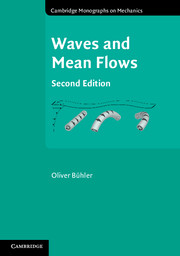Book contents
- Frontmatter
- Dedication
- Contents
- Preface
- PART ONE FLUID DYNAMICS AND WAVES
- PART TWO WAVE–MEAN INTERACTION THEORY
- 5 Zonally symmetric wave–mean interaction theory
- 6 Internal gravity waves
- 7 Shear flows
- 8 Three-dimensional rotating flow
- 9 Rossby waves and balanced dynamics
- 10 Lagrangian-mean theory
- 11 Zonally symmetric GLM theory
- PART THREE WAVES AND VORTICES
- References
- Index
5 - Zonally symmetric wave–mean interaction theory
Published online by Cambridge University Press: 05 April 2014
- Frontmatter
- Dedication
- Contents
- Preface
- PART ONE FLUID DYNAMICS AND WAVES
- PART TWO WAVE–MEAN INTERACTION THEORY
- 5 Zonally symmetric wave–mean interaction theory
- 6 Internal gravity waves
- 7 Shear flows
- 8 Three-dimensional rotating flow
- 9 Rossby waves and balanced dynamics
- 10 Lagrangian-mean theory
- 11 Zonally symmetric GLM theory
- PART THREE WAVES AND VORTICES
- References
- Index
Summary
This is the classic body of wave-mean interaction theory that has been developed extensively in atmospheric fluid dynamics since the late 1960s. Here ‘zonal symmetry’ refers to basic flows that are independent of longitude, which is a natural starting point for analysing large-scale atmospheric flows. As we know, such basic flows induce a conservation law for the zonal component of the pseudomomentum vector, and much of the classic interaction theory is focused on the interplay between zonal pseudomomentum and the zonal component of the mean velocity field.
Many interesting and powerful results are available in this theory, such as so-called ‘non-acceleration conditions’, which provide criteria for whether the presence of waves may lead to an acceleration of the zonal mean flow. Another example is the ‘pseudomomentum rule’, which makes precise the impact of wave dissipation on mean-flow acceleration.
Against these obvious successes of the classic theory must be weighed its obvious restrictions to zonally symmetric basic flows. For instance, it has been much harder to apply this theory in the ocean, where mean circulations (with few exceptions such as the Antarctic circumpolar current) are hemmed-in by the continents and therefore are manifestly not independent of longitude. This problem is compounded by the fact that many results of the zonally symmetric theory do not apply even approximately in a situation with a slowly varying mean flow. We will go beyond zonal symmetry in part THREE of this book.
Information
- Type
- Chapter
- Information
- Waves and Mean Flows , pp. 101 - 106Publisher: Cambridge University PressPrint publication year: 2014
